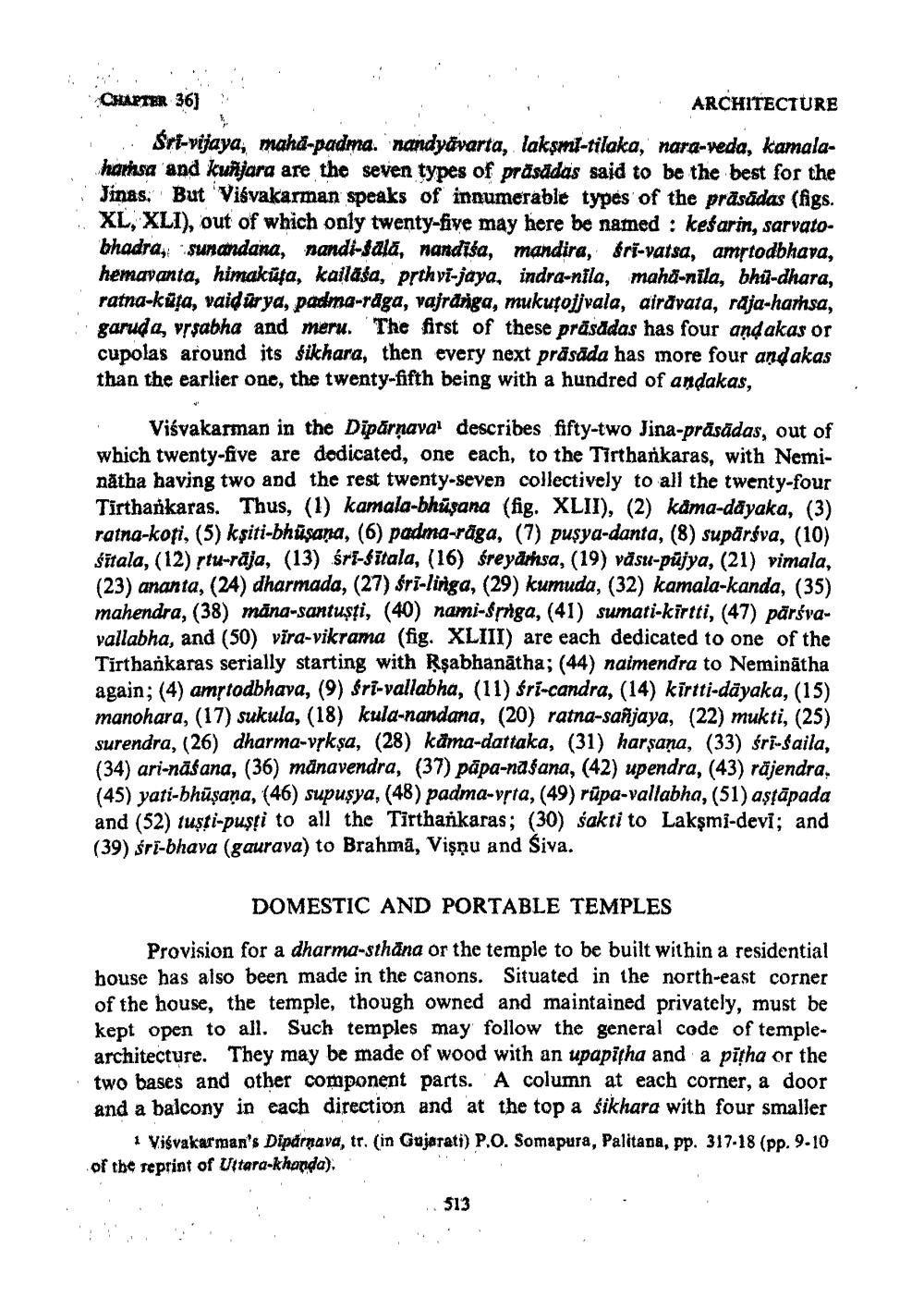________________
CHAPTER 36)
ARCHITECTURE - Sri-vijaya, maha-padma. nandyavarta, laksmi-tilaka, nara-veda, kamalaharsa 'and kunjara are the seven types of präsådas said to be the best for the Jinas. But Vibvakarman speaks of innumerable types of the prasādas (figs. XL, XLI), out of which only twenty-five may here be named : kefarin, sarvatobhadra, sunandana, nandi-sala, nandića, mandira, fri-vatsa, amstodbhava, hemavanta, himakūta, kailasa, prthvi-jaya, indra-nila, maha-nila, bhu-dhara,
küta, vaid ürya, padma-råga, vajranga, mukutoijvala, airāvata, raja-hansa, garuda, vrsabha and meru. The first of these präsådas has four and akas or cupolas around its śikhara, then every next präsåda has more four andakas than the earlier one, the twenty-fifth being with a hundred of andakas,
Viśvakarman in the Diparnaval describes fifty-two Jina-prāsādas, out of which twenty-five are dodicated, one each, to the Tirtharkaras, with Neminätha having two and the rest twenty-seven collectively to all the twenty-four Tirthankaras. Thus, (1) kamala-bhūşana (fig. XLII), (2) käma-dayaka, (3) ratna-kopi, (5) kşiti-bhūsana, (6) padma-rāga, (7) pusya-danta, (8) supäráva, (10) sitala, (12) stu-rāja, (13) śri-fitala, (16) śreyårsa, (19) väsu-pujya, (21) vimala, (23) ananta, (24) dharmada, (27) śri-linga, (29) kumuda, (32) kamala-kanda, (35) mahendra, (38) mana-santuști, (40) nami-srnga, (41) sumari-kirtti, (47) pärsvavallabha, and (50) vira-vikrama (fig. XLIII) are each dedicated to one of the Tirthankaras serially starting with Rşabhanātha; (44) naimendra to Neminātha again; (4) amstodbhava, (9) Sri-vallabha, (11) śri-candra, (14) kirtti-dayaka, (15) manohara, (17) sukula, (18) kula-nandana, (20) ratna-sanjaya, (22) mukti, (25) surendra, (26) dharma-vskșa, (28) käma-dattaka, (31) harsana, (33) śri-saila, (34) ari-näsana, (36) mänavendra, (37) pāpa-nasana, (42) upendra, (43) räjendra, (45) yati-bhüşana, (46) supuşya, (48) padma-ysta, (49) rūpa-vallabha, (51) aştāpada and (52) tusti-pussi to all the Tirthankaras; (30) Śakti to Lakşmi-devi; and (39) sri-bhava (gaurava) to Brahma, Vişnu and Siva.
DOMESTIC AND PORTABLE TEMPLES Provision for a dharma-sthāna or the temple to be built within a residential house has also been made in the canons. Situated in the north-east corner of the house, the temple, though owned and maintained privately, must be kept open to all. Such temples may follow the general code of templearchitecture. They may be made of wood with an upapitha and a pitha or the two bases and other component parts. A column at each corner, a door and a balcony in each direction and at the top a śikhara with four smaller
1 Viśvakarman's Diparnava, tr. (in Gujarati) P.O. Somapura, Palitana, pp. 317-18 (pp. 9-10 of the reprint of Uttara-khonda),
513




